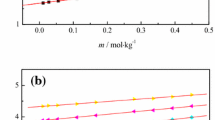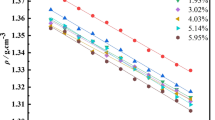Abstract
A rigorous thermodynamic treatment appropriate for surface adsorption from mixed aqueous solution of alkali and polyprotic acid was derived. Those equations were applied to mixed aqueous solution/air systems of alkali metal hydroxide and FeIII complex with ethylenediamine- N, N, N′,N′-tetraacetate (Fe-EDTA). Surface density of each species arising from Fe-EDTA was separately evaluated, and thus, surface activity of Fe-EDTA was studied, especially its dependence on pH and how it is influenced by the counter cations. Fe-EDTA was positively adsorbed at the water/air interface at very low pHs and negatively at high pHs. The pH range of positive adsorption of Fe-EDTA with potassium ion, as a counter ion, was wider than that with sodium ion. Thus, potassium ion, a structure breaker, tended to smooth surface adsorption of Fe-EDTA at the water/air interface, whereas sodium ion, a structure maker, tended to withdraw Fe-EDTA from the interfacial region.









Similar content being viewed by others
References
Bernal JD, Fowler RH (1933) J Chem Phys 1:515
Samoilov (1965) Structure of aqueous electrolyte solutions and hydration of ions. Consultants Bureau, New York
Ohtaki H, Radnai T (1993) Chem Rev 93:1157
Mähler J, Persson I (2012) Inorg Chem 51(425). doi:10.1021/ic2018693
Onsager L, Samaras NNT (1934) J Chem Phys 2:528. doi:10.1063/1.1749522
Gouy LG (1910) J de Physique Théorique et Appliquée 9(4):457. doi:10.1051/jphystap:019100090045700
Chapman DL (1913) Phylos Mag Ser 6 25(148):475. doi:10.1080/14786440408634187
Spaarnay MJ (1958) Recueil des Travaux Chimiques des Pays-Bas 77(9):872. doi:10.1002/recl.19580770911
Ninham BW, Yaminsky V (1997) Langmuir 13(7):2097
Ruckenstein E, Schiby D (1985) Langmuir 1(5):612
Manciu M, Ruckenstein E (2002) Langmuir 18(13):5178
Manciu M, Ruckenstein E (2003) Adv Colloid Inter Sci 105(1):63
Weissenborn P, Pugh RJ (1996) J Colloid Inter Sci 184(2):550
Lambert JL, Godsey CE, Seitz LM (1963) Inorg Chem 2(1):127. doi:10.1021/ic50005a033
Motekaitis RJ, Martell AE, Hayes D, Frenier WW (1980) Can J Chem 58(19):1999. doi:10.1139/v80-318
Motomura K (1978) J Colloid Interface Sci 64:348
Ikeda S (1977) Bull Chem Soc Japan 50(6):1403
Takeda M (1986) Hyper Inter 28(1–4):737
Sakamoto H, Murao A, Hayami Y (2002) J ITE Japan 56(10):1643
Motomura K, Iwanaga S, Hayami Y, Uryu S, Matuura R (1981) J Colloid Interface Sci 80(1):32
Buch V, Milet A, Vácha R, Jungwirth P, Devlin JP (2007) Proc Nat Acad Sci 104(18):7342. doi:10.1073/pnas.0611285104
Jungwirth P (2009) Faraday Discuss 141:9. doi:10.1039/b816684f
Beattie JK, Djerdjev AM, Warr GG (2009) Faraday Discussions 141:31. doi:10.1039/b805266b
Gray-Weale A, Beattie JK (2009). Physical Chemistry Chemical Physics 11(46):10994. doi:10.1039/b901806a
Manciu M, Ruckenstein E (2012) Colloids Surf A 400:27. doi:10.1016/j.colsurfa.2012.02.038
Manciu M, Ruckenstein E (2012) Colloids Surf A 404:93. doi:10.1016/j.colsurfa.2012.04.020
Takahashi M (2005) J Phys Chem B 109(46):21858. doi:10.1021/jp0445270
Li C, Somasundaran P (1991) J Colloid Inter Sci 146(1):215
Tarbuck TL, Ota ST, Richmond GL (2006) J Am Chem Soc 128:14519. doi:10.1021/ja063184b
Takagi S (1991) Mugineic Acid. Hakuyusya Press, Tokyo, pp 5–21
Sakaguchi T, Nishizawa NK, Nakanishi H, Yoshimura E, Mori S (1999). Plant Soil 215(2):221
Curie C, Panaviene Z, Loulergue C, Dellaporta SL, Briat JF, Walker EL (2001) Nature 409:346
Inoue H, Kobayashi T, Nozoye T, Takahashi M, Kakei Y, Suzuki K, Nakazono M, Nakanishi H, Mori S, Nishizawa NK (2009) J Biol Chem 284:3470
Lee S, Chiecko JC, Kim SA, Walker EL, Lee Y, Guerinot ML, An G (2009) Plant Physiol 150:786
Murata Y, Ma JF, Yamaji N, Ueno D, Nomoto K, Iwashita T (2006) Plant J 46:563
Landsberg EC (1981) J Plant Nutr 3:579
Alam S, Kamei S, Kawai S (2001) J Plant Nutr 47(3):643. doi:10.1080/00380768.2001.10408428
Nomoto K, Sugiura Y, Takagi SMugineic acids, studies on phytosiderophores (VCH Verlagsgesellschaft Weinhelm, FRG, 1987), pp 401–425
Acknowledgments
M. V. thanks Professor Emeritus Akira Nagasawa of Graduate School of Science and Engineering, Saitama University for the fruitful discussion and Associate Professor Takashi Fujihara of Graduate School of Science and Engineering, Saitama University for the X-ray crystallography measurement on Fe III(H 2O)(Hedta) crystal.
Author information
Authors and Affiliations
Corresponding author
Appendix
Appendix
Partial differentiations of α 1, α 2, δ and \(m_{\text {OH}^{-}}\) with respect to m i
It would be easier if the partial derivatives (∂ α 1/∂ m i ) T, p, m j ≠ i , (∂ α 2/∂ m i ) T, p, m j ≠ i , (∂ δ/∂ m i ) T, p, m j ≠ i , and \((\partial m_{\text {OH}^{-}} / \partial m_{i})_{T,p, m_{j\not = i}}\) can be calculated numerically. Partial differentiation of p K a1, p K a2, and p K d and Eq. 22 combined with Eqs. 9 ∼14, with respect to m i (i = 1 or 2) give the following relations. Namely, \((\partial \mathrm {p}K_{\mathrm {a}_{1}} / \partial m_{i})_{T,p,m_{j\not = i}} = -(\partial \log a_{\mathrm {c}1-} / \partial m_{i})_{T,p,m_{j\not = i}} + (\partial \text {pH} / \partial m_{i})_{T,p,m_{j\not = i}} + (\partial \log a_{\mathrm {c}0} / \partial m_{i})_{T,p,m_{j\not = i}}\) gives
\((\partial \mathrm {p}K_{\mathrm {a}_{2}} / \partial m_{i})_{T,p,m_{j\not = i}} = -(\partial \log a_{\mathrm {c}2-} / \partial m_{i})_{T,p,m_{j\not = i}} \\+ (\partial \text {pH} / \partial m_{i})_{T,p,m_{j\not = i}} + (\partial \log a_{\mathrm {c}1-} / \partial m_{i})_{T,p,m_{j\not = i}}\) gives
\((\partial \mathrm {p}K_{\mathrm {d}} / \partial m_{i})_{T,p,m_{j\not = i}} = -(\partial \log a_{\text {cd}} / \partial m_{i})_{T,p,m_{j\not = i}} - (\partial \text {pH} / \partial m_{i})_{T,p,m_{j\not = i}} + 2(\partial \log a_{\text {cd}} / \partial m_{i})_{T,p,m_{j\not = i}}\) gives
with χ(i) being
and \(\left \{\partial \left (m_{\text {OH}^{-}} -\frac {K_{\mathrm {w}}}{\gamma _{\mathrm {H}^{+}}\gamma _{\text {OH}^{-}}m_{\text {OH}^{-}}}\right )/ \partial m_{i}\right \}_{T,p,m_{j\not = i}} = \left [ \partial \{m_{1} -m_{2} \alpha _{1} (1+\alpha _{2})\} / \partial m_{i} \right ]_{T,p,m_{j\not = i}}\) gives
and
Thus, partial derivatives of the molality of hydroxide ion \(m_{\text {OH}^{-}}\), the degrees of dissociation of the complex α 1 and α 2, and the degree of dimerization of the complex δ with respect to the molality of sodium hydroxide, m 1 constitutes the following simultaneous linear equations.
where
where 𝒟 is defined by
Similarly, partial derivatives of \(m_{\text {OH}^{-}}\), α 1, α 2, and δ with respect to m 2 constitute the following simultaneous equations.
The partial derivatives \((\partial m_{\text {OH}^{-}} /\partial m_{i})_{T,p,m_{j\neq i}}\), (∂ α 1/∂ m i ) T, p, m j ≠ i , (∂ α 2/∂ m i ) T, p, m j ≠ i , and (∂ δ/∂ m i ) T, p, m j ≠ i (i = 1 or 2) are obtained by solving the above simultaneous equations by using Cramer’s rule.
Rights and permissions
About this article
Cite this article
Villeneuve, M., Tanaka, M., Abe, M. et al. Adsorption of polyprotic acid at the water/air interface. Colloid Polym Sci 292, 2335–2348 (2014). https://doi.org/10.1007/s00396-014-3203-2
Received:
Revised:
Accepted:
Published:
Issue Date:
DOI: https://doi.org/10.1007/s00396-014-3203-2




